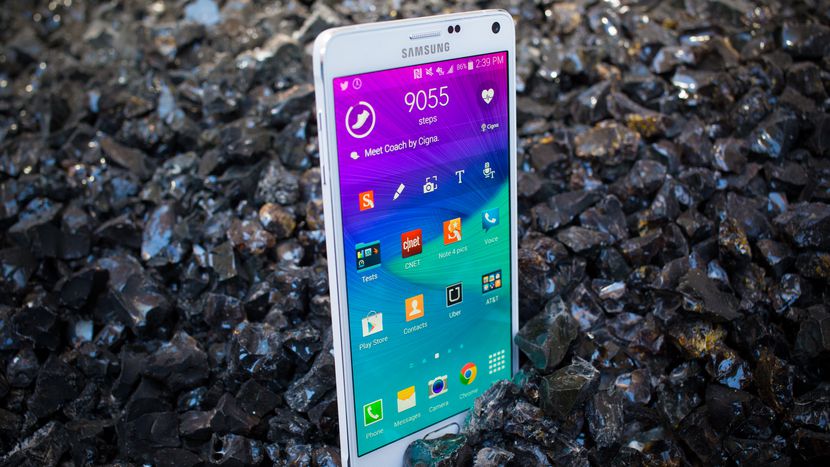How to root Samsung Galaxy Note 4

In this guide, we will be introducing you to access root privileges in your Samsung Galaxy Note 4. If you are an Android user, you might already have a fair idea that you can manipulate your experience on an Android phone very easily and to a great extent. Regardless of whatever manufacturer has made your smartphone, you can truly take control of your smartphone. Mostly users install custom ROMs and skins etc. from the application store, much greater freedom can, however, only be attained through rooting your smartphone.
We have already discussed what Android rooting really is. After introducing it in general, we moved on and introduced you to some of rooting guides. Today, we will be talking about how can you root your Samsung Galaxy Note 4 smartphone.
We will be rooting Samsung Galaxy Note 4 N910* smartphone running using the widely acclaimed CF-Auto Root through Odin on a PC. There are ways to root your smartphones without using a PC through many one click rooting applications that are available at application stores. Although using one-click root application is very easier, the roots are temporary and you will again have to root after reboot.
Disclaimer: Rooting your Samsung smartphone will void its manufacturer’s warranty and you may damage your device. In case of any damage in any form while following this tutorial, TJ is not to be held responsible in anyways. Proceed at your own risk.
Process:
1. Back-Up
The first step to any rooting solution is mostly the same. Although there is a slim chance that you would loose your data or damage the device, it is recommended that you do a back-up of the data stored on your smartphone.
You can either
- Copy the data from you mobile to your SD card and remove it.
- Transfer data to your PC.
- Samsung backups can also be done through using Samsung Kies.
2. Download USB drivers for ROOTING your Samsung Galaxy Note 4
Download the USB drivers for your smartphone and install them on your computer. This will enable you to connect your smartphone with your PC successfully.
You can use either of the following links.
- Download Samsung USB Drivers from here
- Download Samsung KIES (The package bundles drivers)
3. Enable USB debugging mode on your SAmsung Galaxy Note 4
In order to enable USB debugging on your smartphone, follow these steps.
- Go to Settings on your smartphone
- Scroll down and find ‘Developer Options’ and tap there
- Enable USB debugging and OEM Unlocking
By default the Developer Options aren’t visible in Settings menu. You, however, can make it visible by following these steps.
- Go to Settings on your smartphone
- Scroll down till you see “About Device” or “About Phone” and tap there
- Tap on Build Number for 5-7 times to make the Developer Options visible
- Now follow the standard steps to enable USB debugging and OEM Unlocking
4. Download the root package for your Note 4
You will be required to download the root package for your Note 4 device. The root packages are different for every variant of the Samsung Galaxy Note 4, depending on your region of purchase. So, follow these steps to check what model you have.
- Go to Settings on your smartphone
- Scroll down till you see “About Device” or “About Phone” and tap there
- Note down the model number
Now using the links given below download the root package for your model.
- Download CF Auto-Root for SM-N910F (International, Qualcomm): CF-Auto-Root-trlte-trltexx-smn910f.zip
- Download CF Auto-Root for SM-N910G (Asia, Qualcomm): CF-Auto-Root-trlte-trltedt-smn910g.zip
- Download CF Auto-Root for SM-N910H (Asia, Exynos): CF-Auto-Root-tre3g-tre3gxx-smn910h.zip
Next you would need to download Odin, a software you would be using to flash your smartphone.
- Download the Odin3
- Save the file on your PC and extract it.
Before moving to the next step, please make sure that you have sufficient battery in your smartphone. Also have to deactivate any anti-virus program in your computer.
5. Open your smartphone in Fastboot mode
Follow these steps to open your smartphone in Fastboot mode.
- Disconnect your smartphone from PC.
- Switch off the smartphone.
- Press Volume Up key to confirm.
Once your device boots into the Fastboot mode (sometimes also called the Download Mode), connect it to your computer using the original USB data cable.
6. Process on your PC
After connecting the smartphone to your PC, open the folder where you have downloaded the Odin.
- Find the Odin3.exe file and open it. If you have USB drivers of your device in your PC, you will automatically be able to see ‘Added’ in the Odin dialogue box.
- Click on ‘AP’/’PDA‘ button and select the extracted file by going to the folder where you have extracted the CF Auto-Root package (it should be a CF-Auto-Root-….tar.md5).
- Check the Auto Reboot and F. Reset Time options, if not already checked.
- Click the ‘Start’ button.
As soon as you would click the Start button, the flashing process will start automatically. After the process is finished, your device will automatically boot into the rooted mode. You can confirm if your device has correctly been rooted or not, by downloading any root checker application from Google PlayStore and check for root privileges. You can also simply check for the SuperSU application in your smartphone.
Want such a how-to rooting guide of any other phone? Just mention name of the smartphone in the comments section below and we will be more than happy to look into it.
Image — Cnet
I love to talk about global tech-happenings, startups, industry, education and economy. Get in touch: [email protected].
Related Posts
Tecno Pakistan Maintains Steady Local Manufacturing Output in 2025
ISLAMABAD: Tecno has successfully maintained its presence in local mobile manufacturing, displaying consistency despite industry fluctuations. According to the latest data, Tecno’s locally assembled…
Vivo Pakistan Faces Sharp Decline in Local Manufacturing in Early 2025
ISLAMABAD: Vivo, a prominent player in the local mobile manufacturing market, has experienced a significant drop in production in early 2025. According to the…














